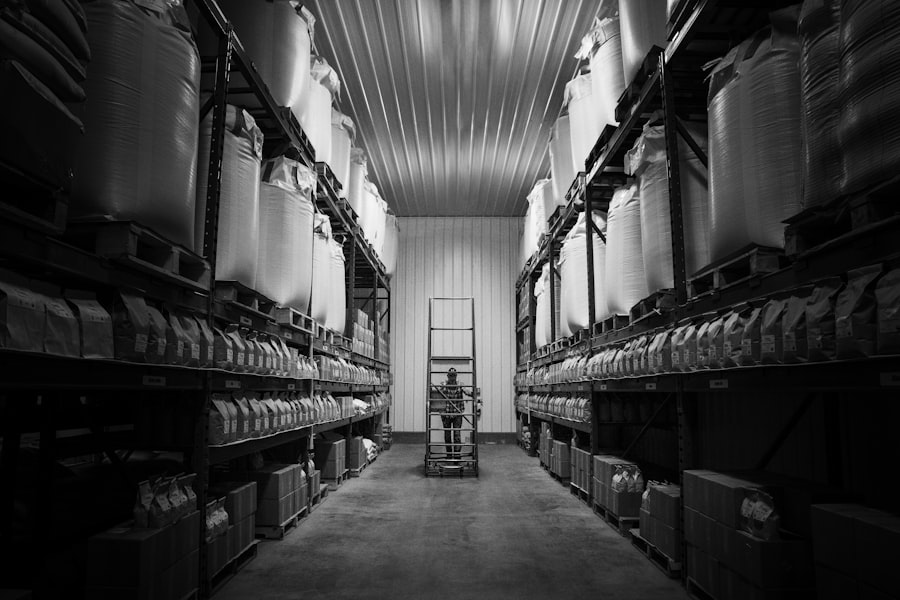Technology has transformed logistics and warehousing operations, introducing automation, robotics, data analytics, and predictive maintenance to enhance efficiency, accuracy, and speed in the supply chain industry. The growth of e-commerce and global trade has intensified the need for advanced technology in these sectors. Companies are actively seeking innovative solutions to optimize their operations and meet increasing consumer demands, making technology adoption essential in logistics and warehousing.
The integration of technology has improved various aspects of logistics and warehousing, including inventory management, tracking systems, and supply chain visibility. Data analytics and predictive maintenance enable companies to make informed decisions and prevent costly downtime. The Internet of Things (IoT) connects devices and sensors, providing real-time data for better decision-making.
Drones and autonomous vehicles have revolutionized goods transportation and delivery, increasing efficiency and cost-effectiveness. As technology continues to advance, the logistics and warehousing sectors are poised for further innovation and improvement.
Key Takeaways
- Technology has revolutionized the logistics and warehousing industry, leading to increased efficiency and productivity.
- Automation and robotics have transformed warehousing operations, leading to faster and more accurate order fulfillment.
- Inventory management and tracking systems have enabled real-time visibility and control over stock levels, reducing the risk of stockouts and overstocking.
- Data analytics and predictive maintenance have allowed for proactive equipment maintenance, reducing downtime and increasing operational efficiency.
- The Internet of Things (IoT) has improved supply chain visibility, allowing for better tracking and monitoring of goods in transit.
Automation and Robotics in Warehousing
The use of automation and robotics in warehousing has revolutionized the way goods are stored, picked, and packed. Automated guided vehicles (AGVs) and robotic arms have significantly reduced the need for manual labor, leading to increased efficiency and accuracy in warehouse operations. These technologies have also enabled warehouses to optimize their storage space and reduce the risk of human error.
With the help of advanced software and sensors, robots can now navigate through warehouses, pick up items, and transport them to the desired location without any human intervention. This level of automation has not only improved productivity but also enhanced safety measures within warehouses. Furthermore, the integration of robotics in warehousing has led to the development of collaborative robots, also known as cobots, which work alongside human workers to perform tasks that require precision and strength.
These cobots have proven to be valuable assets in warehouse operations, as they can handle repetitive tasks while allowing human workers to focus on more complex responsibilities. The use of automation and robotics in warehousing is expected to continue growing as companies strive to further optimize their operations and meet the increasing demands of consumers. As technology continues to advance, we can expect to see even more sophisticated robotics solutions that will further transform the way warehouses operate.
Inventory Management and Tracking Systems
The implementation of advanced inventory management and tracking systems has significantly improved the accuracy and efficiency of warehouse operations. With the use of barcode scanning, RFID technology, and advanced software, companies can now track their inventory in real-time and minimize the risk of stockouts or overstock situations. These systems have also enabled warehouses to optimize their storage space and reduce the time it takes to locate specific items.
Additionally, the integration of inventory management systems with enterprise resource planning (ERP) software has provided companies with a comprehensive view of their inventory levels, allowing for better decision-making and improved supply chain management. Moreover, the use of tracking systems has enhanced visibility throughout the supply chain, enabling companies to monitor the movement of goods from the point of origin to the final destination. This level of transparency has not only improved customer satisfaction but also allowed companies to identify potential bottlenecks or inefficiencies within their operations.
As technology continues to advance, we can expect to see even more sophisticated inventory management and tracking systems that will further streamline warehouse operations and provide valuable insights for decision-making.
Data Analytics and Predictive Maintenance
Data analytics and predictive maintenance have become essential tools for optimizing warehouse operations and preventing costly downtime. By analyzing large volumes of data, companies can now identify patterns, trends, and potential issues within their operations. This level of insight has enabled companies to make informed decisions and implement proactive measures to prevent equipment failures or disruptions in their operations.
With the help of predictive maintenance, companies can now schedule maintenance tasks based on actual equipment performance rather than predetermined schedules, leading to reduced downtime and increased productivity. Furthermore, data analytics has provided companies with valuable insights into consumer behavior, market trends, and demand forecasting. By leveraging this data, companies can make more accurate predictions about future demand and adjust their inventory levels accordingly.
This level of foresight has not only improved inventory management but also enabled companies to better meet the demands of consumers. As technology continues to advance, we can expect to see even more sophisticated data analytics solutions that will further enhance decision-making and operational efficiency within warehouses.
Internet of Things (IoT) and Supply Chain Visibility
The Internet of Things (IoT) has played a crucial role in providing real-time data for better decision-making and supply chain visibility. By connecting various devices and sensors, companies can now track the movement of goods, monitor equipment performance, and optimize their operations in real-time. This level of connectivity has not only improved operational efficiency but also enabled companies to identify potential issues before they escalate into larger problems.
With the help of IoT, companies can now have a comprehensive view of their entire supply chain, allowing for better coordination and collaboration between various stakeholders. Moreover, IoT has enabled companies to implement smart warehouse solutions that automate various tasks such as inventory management, temperature control, and security monitoring. These solutions have not only improved operational efficiency but also reduced the risk of human error within warehouses.
As technology continues to advance, we can expect to see even more innovative IoT solutions that will further enhance supply chain visibility and operational efficiency.
Drones and Autonomous Vehicles in Logistics
Efficient Last-Mile Delivery
Drones have proven to be valuable assets for last-mile delivery, as they can navigate through congested urban areas and deliver goods directly to consumers’ doorsteps. This level of efficiency has not only reduced delivery times but also improved customer satisfaction.
Optimized Transportation and Safety
Furthermore, autonomous vehicles have enabled companies to optimize their transportation routes and reduce fuel consumption, leading to cost savings and environmental benefits. Additionally, the use of drones and autonomous vehicles has improved safety measures within logistics operations by reducing the risk of accidents or human error.
Increased Productivity and Future Advancements
These technologies have also enabled companies to operate around the clock without the need for human intervention, leading to increased productivity and operational efficiency. As technology continues to advance, we can expect to see even more sophisticated drones and autonomous vehicles that will further transform the way goods are transported and delivered.
The Future of Technology in Logistics and Warehousing
The future of technology in logistics and warehousing holds even more exciting possibilities for innovation and improvement. With the rise of artificial intelligence (AI), machine learning, and blockchain technology, we can expect to see even more sophisticated solutions that will further optimize warehouse operations and supply chain management. AI-powered predictive analytics will enable companies to make more accurate predictions about future demand and adjust their operations accordingly.
Machine learning algorithms will provide valuable insights into consumer behavior and market trends, allowing companies to better meet the demands of consumers. Furthermore, blockchain technology will revolutionize supply chain management by providing a secure and transparent platform for tracking the movement of goods from the point of origin to the final destination. This level of transparency will not only improve trust between various stakeholders but also reduce the risk of fraud or counterfeit goods within the supply chain.
As technology continues to advance, we can expect to see even more innovative solutions that will further transform the way logistics and warehousing operations are conducted. In conclusion, technology has become an integral part of logistics and warehousing operations, revolutionizing the way goods are stored, picked, packed, transported, and delivered. The integration of automation, robotics, data analytics, IoT, drones, autonomous vehicles, AI, machine learning, and blockchain technology has significantly improved efficiency, accuracy, speed, visibility, safety measures, customer satisfaction, cost savings, environmental benefits, trust between stakeholders, decision-making processes, supply chain management, inventory management, predictive maintenance, operational efficiency within warehouses.
As technology continues to advance at a rapid pace, we can expect even more exciting possibilities for innovation and improvement in the future of logistics and warehousing.
If you’re interested in understanding how technology is reshaping various industries, you might find the article on How to Start Affiliate Marketing in 2023 particularly enlightening. While it focuses on the digital marketing sector, the principles of leveraging advanced software and platforms can be paralleled with the technological transformations in logistics and warehousing. Both fields are increasingly dependent on digital tools and analytics to optimize operations and enhance efficiency, illustrating a broader trend of tech integration into business practices.
FAQs
What is the role of technology in logistics and warehousing?
Technology plays a crucial role in streamlining operations, improving efficiency, and enhancing visibility in logistics and warehousing. It enables real-time tracking of shipments, inventory management, and automation of various processes.
How does technology improve efficiency in logistics and warehousing?
Technology improves efficiency by optimizing route planning, reducing manual errors, automating repetitive tasks, and providing real-time data for better decision-making. This leads to faster delivery times, lower operational costs, and improved customer satisfaction.
What are some examples of technology used in logistics and warehousing?
Examples of technology used in logistics and warehousing include warehouse management systems (WMS), transportation management systems (TMS), barcode scanning, RFID tracking, autonomous vehicles, drones, and predictive analytics.
How does technology enhance visibility in logistics and warehousing?
Technology enhances visibility by providing real-time tracking of shipments, inventory levels, and overall supply chain performance. This allows for better coordination, proactive problem-solving, and improved customer communication.
What are the benefits of adopting technology in logistics and warehousing?
The benefits of adopting technology in logistics and warehousing include improved operational efficiency, reduced costs, better inventory management, enhanced customer service, and the ability to adapt to changing market demands.



